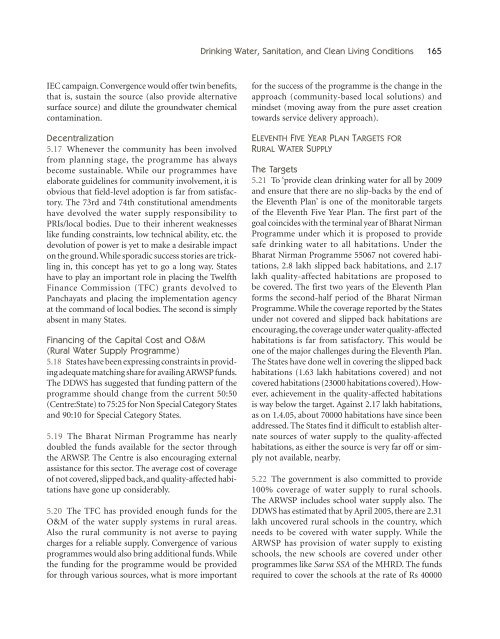Eleventh Five Year Plan
Eleventh Five Year Plan
Eleventh Five Year Plan
You also want an ePaper? Increase the reach of your titles
YUMPU automatically turns print PDFs into web optimized ePapers that Google loves.
Drinking Water, Sanitation, and Clean Living Conditions 165IEC campaign. Convergence would offer twin benefits,that is, sustain the source (also provide alternativesurface source) and dilute the groundwater chemicalcontamination.Decentralization5.17 Whenever the community has been involvedfrom planning stage, the programme has alwaysbecome sustainable. While our programmes haveelaborate guidelines for community involvement, it isobvious that field-level adoption is far from satisfactory.The 73rd and 74th constitutional amendmentshave devolved the water supply responsibility toPRIs/local bodies. Due to their inherent weaknesseslike funding constraints, low technical ability, etc. thedevolution of power is yet to make a desirable impacton the ground. While sporadic success stories are tricklingin, this concept has yet to go a long way. Stateshave to play an important role in placing the TwelfthFinance Commission (TFC) grants devolved toPanchayats and placing the implementation agencyat the command of local bodies. The second is simplyabsent in many States.Financing of the Capital Cost and O&M(Rural Water Supply Programme)5.18 States have been expressing constraints in providingadequate matching share for availing ARWSP funds.The DDWS has suggested that funding pattern of theprogramme should change from the current 50:50(Centre:State) to 75:25 for Non Special Category Statesand 90:10 for Special Category States.5.19 The Bharat Nirman Programme has nearlydoubled the funds available for the sector throughthe ARWSP. The Centre is also encouraging externalassistance for this sector. The average cost of coverageof not covered, slipped back, and quality-affected habitationshave gone up considerably.5.20 The TFC has provided enough funds for theO&M of the water supply systems in rural areas.Also the rural community is not averse to payingcharges for a reliable supply. Convergence of variousprogrammes would also bring additional funds. Whilethe funding for the programme would be providedfor through various sources, what is more importantfor the success of the programme is the change in theapproach (community-based local solutions) andmindset (moving away from the pure asset creationtowards service delivery approach).ELEVENTH FIVE YEAR PLAN TARGETS FORRURAL WATER SUPPLYThe Targets5.21 To ‘provide clean drinking water for all by 2009and ensure that there are no slip-backs by the end ofthe <strong>Eleventh</strong> <strong>Plan</strong>’ is one of the monitorable targetsof the <strong>Eleventh</strong> <strong>Five</strong> <strong>Year</strong> <strong>Plan</strong>. The first part of thegoal coincides with the terminal year of Bharat NirmanProgramme under which it is proposed to providesafe drinking water to all habitations. Under theBharat Nirman Programme 55067 not covered habitations,2.8 lakh slipped back habitations, and 2.17lakh quality-affected habitations are proposed tobe covered. The first two years of the <strong>Eleventh</strong> <strong>Plan</strong>forms the second-half period of the Bharat NirmanProgramme. While the coverage reported by the Statesunder not covered and slipped back habitations areencouraging, the coverage under water quality-affectedhabitations is far from satisfactory. This would beone of the major challenges during the <strong>Eleventh</strong> <strong>Plan</strong>.The States have done well in covering the slipped backhabitations (1.63 lakh habitations covered) and notcovered habitations (23000 habitations covered). However,achievement in the quality-affected habitationsis way below the target. Against 2.17 lakh habitations,as on 1.4.05, about 70000 habitations have since beenaddressed. The States find it difficult to establish alternatesources of water supply to the quality-affectedhabitations, as either the source is very far off or simplynot available, nearby.5.22 The government is also committed to provide100% coverage of water supply to rural schools.The ARWSP includes school water supply also. TheDDWS has estimated that by April 2005, there are 2.31lakh uncovered rural schools in the country, whichneeds to be covered with water supply. While theARWSP has provision of water supply to existingschools, the new schools are covered under otherprogrammes like Sarva SSA of the MHRD. The fundsrequired to cover the schools at the rate of Rs 40000












![[Tam] Uygula[ya] - Bilim, Teknoloji ve Ä°novasyon Politikaları TartıÅma ...](https://img.yumpu.com/36820041/1/184x260/tam-uygulaya-bilim-teknoloji-ve-anovasyon-politikalara-tartaama-.jpg?quality=85)



